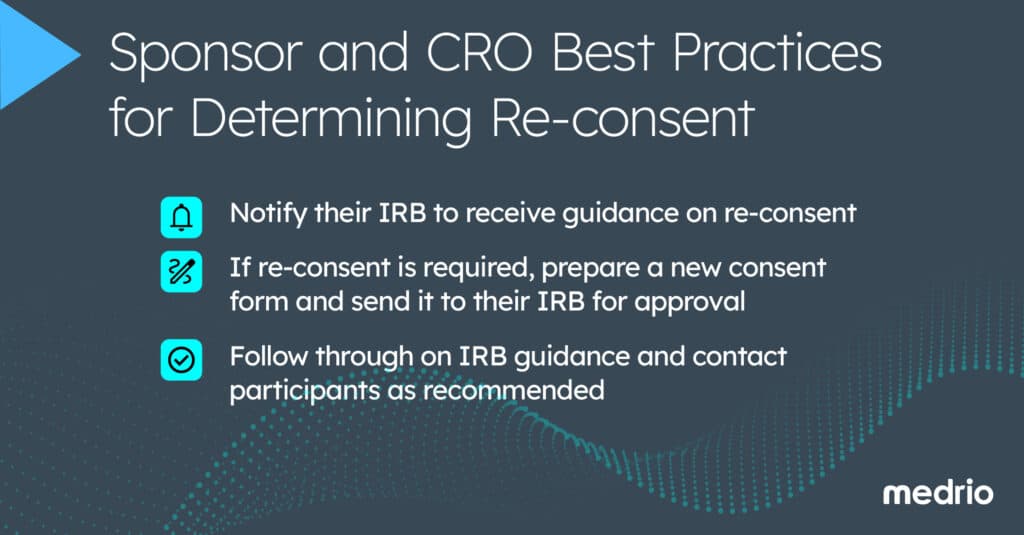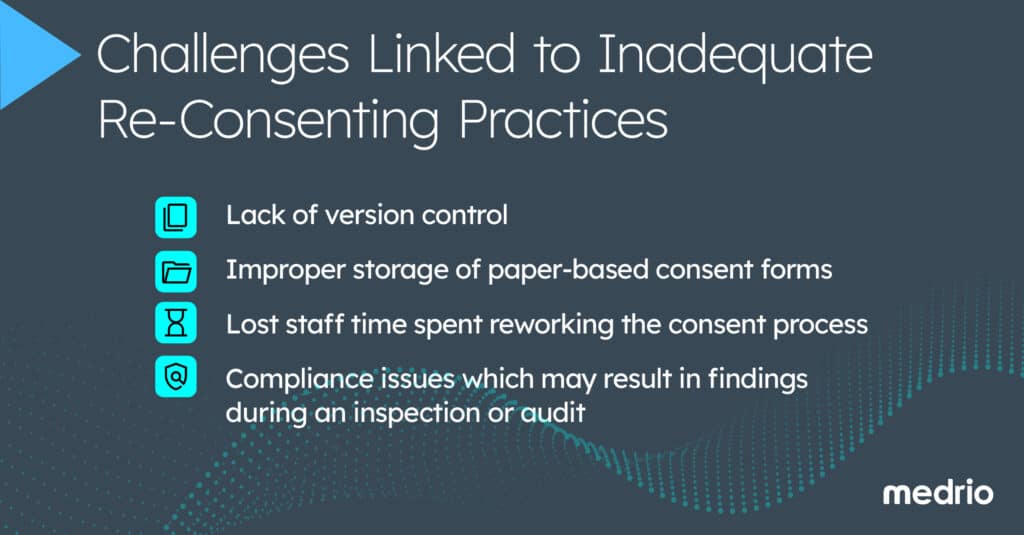Contributing Experts at Medrio: Tina Caruana, eClinical Solutions Subject Matter Expert, Melissa Newara, VP of Subject Matter Expertise, Rebecca Jones, Product Marketing Manager at Medrio
Informed consent is an ongoing process. When significant changes happen within a trial, Institutional Review Boards (IRBs) will request that participants be given the opportunity to reaffirm their willingness to continue. Therefore, it’s important for sponsors and CROs to start a trial with a consent and
re-consent strategy.
Some of the challenges associated with re-consent are worsened since paper consent forms remain the status quo at many sites.
For example, after a long day of explaining the risks and potential benefits of a trial and getting signatures, a site staff member may realize the last participant signed an old version of a consent form. Now they need to find out how many other old copies were accidentally in circulation.
In this article, learn about:
- What could trigger a re-consent
- What regulators and IRBs say about re-consent
- How digital processes can prevent issues tied to re-consent
What Could Trigger a Re-consent?
Sites and sponsors should re-consent study participants when significant changes occur that could impact a participant’s understanding of the nature of the study and their willingness to continue.
There are a variety of factors that might trigger a re-consent:
- Moving participants to different treatment arms
- Dosage changes
- Risk ratio changes (harm vs benefit)
- An alternative treatment becomes available
- A newly named Principal Investigator declares a conflict of interest
- Changes are made to an adaptive study design
- Pediatric participants reach adulthood while the study is still ongoing
- A substantial period of time has elapsed between the time consent was obtained and the study begins
Not all protocol amendments automatically trigger a re-consent. For example, it’s unlikely that eliminating a blood draw at a single visit would create a scenario where every participant needs to re-consent. A verbal discussion with the participant may be sufficient in such cases as sharing simple information. And minor changes—such as correcting nonsubstantive typographical errors—would also not trigger a re-consent process.
Admittedly, it can be challenging to decipher when a re-consent is needed versus a less formal process. IRBs are best able to provide guidance on when full re-consent is required.

Regulatory & IRB Recommendations for
Re-consent
A journal article on re-consent defines it as “an action in which a subject (or representative) makes the decision to participate in research once again.” But when is a formal re-consent process actually necessary?
US federal regulations require consent forms to tell participants they’ll be kept up-to-date with “significant new findings developed during the course of the study.” Therefore, participants must be advised of significant new findings and changes that affect them during the study.
However, the details of how this information is provided and documented is not clearly defined in US guidelines.
In fact, the FDA’s 2023 Informed Consent Guidance Document states, “FDA regulations do not use or define the term re-consent, nor do FDA regulations specify the process an IRB should use to determine the need or method to inform subjects who are already enrolled in the study of the new information. As such, IRBs have flexibility to establish procedures they think are appropriate to provide for subjects to have an opportunity to affirm their willingness to continue in the research.”
However, the guidance does state that if there are significant new study findings, the IRB will consider whether participants should be contacted in case the new information affects their willingness to stay in the study.
The guidance also acknowledges that due to this new information, the investigator may need “to revise the consent form to include the new information for new enrollees and obtain IRB review and approval before it is used.”
If the consent form is modified to reflect new information, the IRB will determine whether the investigator needs to provide all currently enrolled subjects with the new information.
Depending on the nature of the change in research, a revised informed consent document (triggering a re-consent process) or an alternative method such as a verbal discussion, a consent addendum, or an information sheet may be appropriate to notify participants.
If there are study changes, sponsors and CROs should:
- Notify their IRB to receive guidance on whether re-consent is necessary
- If re-consent is required, prepare a new consent form and send it to their IRB for approval
- Follow through on IRB guidance and contact participants as recommended

Sponsors and CROs should view informed consent as an ongoing process. Although the 2023 FDA regulatory guidance does not explicitly describe all of the circumstances that might require re-consent, it clearly states that patients must be actively involved in their decision to participate in research.
Therefore, it’s important to understand the conditions for re-consent in the areas in which you are running your trial.
The Risk of Overlooking Re-consent
If an updated consent form is required, all unsigned versions of the prior paper consent form should be discarded—but only if they can be found. If even a single old form is overlooked, it can be accidentally used during the consent process. Worse yet, it can be photocopied and put back into circulation.
Since tracking consent form versions is tied to site compliance, it’s a critical issue. A single outdated form returned into circulation can trigger a huge amount of work for staff since they’ll need to dig back through their files, trying to track down any old forms signed by mistake. They might even need every participant to re-consent.
Poor re-consenting practices are tied to:
- Lack of version control
- Improper storage of paper-based consent forms
- Lost staff time spent reworking the consent process
- Compliance issues which may result in findings during an inspection or audit
And in a worst-case scenario, the trial may be required to remove study data and disqualify participants. Given what’s at stake, sponsors and CROs are wise to look beyond study startup—and make a plan to handle the possibility of re-consent.

eConsent as a Re-consent Solution
As studies move into later phases, so do the challenges associated with re-consent. As studies become more complex and enroll more research participants, electronic consent (eConsent) is an invaluable tool.
Rather than waiting for participants to come in for a site visit, eConsent supports digital re-consent at any time. Consenting electronically with a purpose-built solution also ensures version control, since eConsent allows sites to upload new forms while disabling access to old ones.
eConsent supports rapid and accurate re-consent, automating time-consuming manual processes. It also reduces friction caused by the re-consent process in multiple ways by:
- Ensuring sites only have access to the latest IRB-approved forms
- Automating the process of deploying new consent forms
- Providing a dashboard for oversight of participant re-consent status
As sponsors and CROs weigh the benefits of eConsent adoption, it’s important they plan beyond the initial consent process. After all, to obtain informed consent is much more than signing a piece of paper—it is a continuous process of communication between the investigator and a participant.
Therefore, it’s prudent to look beyond study startup and consider how to handle the likelihood of re-consent. eConsent can offer an efficient method of staying compliant, despite study changes.
Want to solidify your consent and re-consent strategy?
Get in touch with the Medrio team to future-proof your study against changes by using eConsent.
The information in this document is comprised of Medrio’s views and do not constitute for legal or other professional guidance. Please refer to proper industry documentation and consult with your own advisor for legal or professional advice.



